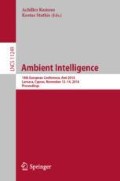Abstract
We present a study in which 59 participants logged their interpersonal conflicts while wearing an Empatica E4 wristband. They marked the beginnings and endings of the conflicts, as well as their intensity. In this paper, the dataset is described and a preliminary analysis is performed. We describe data segmentation and feature calculation process. Next, the interrelationships between the features and labels are explored. A logistic regression model for conflict recognition was built and significant features were selected. Finally, we constructed a machine learning model and proposed how to improve it.
Data collection for this study was supported by a grant to Heidi Mauersberger from the structured graduate program “Self-Regulation Dynamics Across Adulthood and Old Age: Potentials and Limits”. Junoš Lukan’s expenses were covered by Slovenian Research Agency (ARRS, project ref. N2-0081).
Access this chapter
Tax calculation will be finalised at checkout
Purchases are for personal use only
References
Alberdi, A., Aztiria, A., Basarab, A.: Towards an automatic early stress recognition system for office environments based on multimodal measurements: a review. J. Biomed. Inform. 59, 49–75 (2016). https://doi.org/10.1016/j.jbi.2015.11.007
Arlot, S., Celisse, A.: A survey of cross-validation procedures for model selection. Stat. Surv. 4, 40–79 (2010). https://doi.org/10.1214/09-SS054
Gjoreski, M., Gjoreski, H., Luštrek, M., Gams, M.: How accurately can your wrist device recognize daily activities and detect falls? Sensors 16(6) (2016). https://doi.org/10.3390/s16060800
Jones, E., Oliphant, T., Peterson, P., et al.: SciPy: open source scientific tools for Python (2001–2018). http://www.scipy.org/
Lavoie, K.L., Miller, S.B., Conway, M., Fleet, R.P.: Anger, negative emotions, and cardiovascular reactivity during interpersonal conflict in women. J. Psychosom. Res. 51(3), 503–512 (2001). https://doi.org/10.1016/S0022-3999(01)00217-3
Lomb, N.R.: Least-squares frequency analysis of unequally spaced data. Astrophys. Space Sci. 39, 447–462 (1976). https://doi.org/10.1007/BF00648343
Malik, M., et al.: Heart rate variability. Eur. Hear. J. 17(3), 354–381 (1996)
Negri, L.H., Vestri, C.: lucashn/peakutils: v1.1.0, September 2017. https://doi.org/10.5281/zenodo.887917
Neumann, S.A., et al.: Cardiovascular and psychological reactivity and recovery from harassment in a biracial sample of high and low hostile men and women. Int. J. Behav. Med. 18(1), 52–64 (2011). https://doi.org/10.1007/s12529-010-9110-0
Pedregosa, F., et al.: Scikit-learn: machine learning in Python. J. Mach. Learn. Res. 12, 2825–2830 (2011)
Scargle, J.D.: Studies in astronomical time series analysis. II - Statistical aspects of spectral analysis of unevenly spaced data. Astrophys. J. 263, 835–853 (1982). https://doi.org/10.1086/160554
Slapničar, G., Luštrek, M., Marinko, M.: Continuous blood pressure estimation from PPG signal. Informatica 42(1), 33–42 (2018). http://www.informatica.si/index.php/informatica/article/view/2229
Stephenson, E., King, D., DeLongis, A.: Coping process. In: Fink, G. (ed.) Stress: Concepts, Cognition, Emotion, and Behavior, Chap. 44, pp. 359–364. Academic Press, San Diego (2016). https://doi.org/10.1016/B978-0-12-800951-2.00045-5
Tada, M., et al.: Fear conditioning induced by interpersonal conflicts in healthy individuals. PLoS One 10(5), 1–14 (2015). https://doi.org/10.1371/journal.pone.0125729
Author information
Authors and Affiliations
Corresponding author
Editor information
Editors and Affiliations
Rights and permissions
Copyright information
© 2018 Springer Nature Switzerland AG
About this paper
Cite this paper
Lukan, J., Gjoreski, M., Mauersberger, H., Hoppe, A., Hess, U., Luštrek, M. (2018). Analysing Physiology of Interpersonal Conflicts Using a Wrist Device. In: Kameas, A., Stathis, K. (eds) Ambient Intelligence. AmI 2018. Lecture Notes in Computer Science(), vol 11249. Springer, Cham. https://doi.org/10.1007/978-3-030-03062-9_13
Download citation
DOI: https://doi.org/10.1007/978-3-030-03062-9_13
Published:
Publisher Name: Springer, Cham
Print ISBN: 978-3-030-03061-2
Online ISBN: 978-3-030-03062-9
eBook Packages: Computer ScienceComputer Science (R0)


